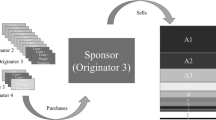Abstract
The objective of this paper is to explore the economic incentives behind the securitisation decision. Securitisation separates loan origination from loan funding, thereby permitting depository institutions the specialisation on the originating function, for which they have a comparative advantage. Securitisation also expands depository institutions’ sources of funding and liquidity. This paper uses a UK data set to empirically test the validity of those two competing hypotheses, the ‘comparative advantage hypothesis’ and the ‘financing hypothesis’. The results support the financing hypothesis.
Similar content being viewed by others
References and Notes
The dependent variable for these studies is the memo item in Schedule L of the report, ‘Loans originated by the reporting bank that have been sold or participated to others’. The types of loans reported under Schedule L exclude residential mortgages and consumer installment loans. This omission creates a serious problem for these empirical studies. A bank securitising only residential mortgages and/or consumer installment loans would not be considered as using securitisation at all if the dependent variable in the econometric study is a binary variable. Alternatively, if the dependent variable is the volume of securitised or sold assets, the volume of securitisation would be underestimated.
James, C. (1988) The use of loan sales and standby letters of credit by commercial banks. Journal of Monetary Economics 22 (3): 395–422.
Flannery, M. J. (1994) Debt maturity and the deadweight cost of leverage: Optimally financing banking firms. American Economic Review, March, 320–331.
Benveniste, L. M. and Berger, A. N. (1987) Securitisation with recourse: An instrument that offers uninsured depositors sequential claims. Journal of Banking and Finance 11 (3): 403–424.
Hess, A. C. and Smith, C. (1988) Elements of mortgage securitization. Journal of Real Estate Finance and Economics 1: 336–346.
Greenbaum, S. and Thakor, A. V. (1987) Bank funding modes: Securitisation versus deposits. Journal of Banking and Finance 11 (3): 379–402.
Boot, A. W. A. and Thakor, A. V. (1993) Security design. Journal of Finance 48 (4): 1349–1378.
Riddiough, T. (1997) Optimal design and governance of asset-backed securities. Journal of Financial Intermediation 6: 121–152.
Flannery, M. J. (1994) Debt maturity and the deadweight cost of leverage: Optimally financing banking firms. American Economic Review 84, March, 320–331.
Deposits may have become relatively expensive because of competition in the household savings market; or deposit supply is insufficient to fund the financial intermediary investment opportunities; or there is a time lag between marketing the deposit products and actually getting them.
By external funds it is meant debt, equity or permanent interest bearing shares (in the case of building societies).
If the firm issues debt instead of securitising assets, the bondholder acquires a claim on the financial intermediary's entire portfolio of assets. In non-recourse securitisation, the investor in asset-backed securities acquires a claim solely on the assets’ pool.
Asset substitution in UK's SPVs is limited to including new assets in the pool when existing ones mature. This right is bounded in time, usually during the first 2 years. But because of investors’ dislike, most of the securitisation transactions do not contemplate the possibility of asset substitution.
It seems reasonable to assume that producing information about, for example, a pool of mortgage loans is less expensive than producing information about the whole portfolio of a depository institution. For example, UK mortgage-backed securities issuing prospectuses contain very detailed information about the bank's lending criteria. The size of loans, the types of mortgage loans and loan-to-value ratio for each type, the borrowers’ income requirements and proof of income, the maturity and geographical distribution of the loans, and details of the mortgage indemnity and property insurance are included in the prospectuses. The prospectuses also have information about the liquidity facilities and mechanism of credit enhancement.
Banks risk neutrality can be due to the presence of deposit insurance. Also less-capitalised banks can be assumed to be riskier than better-capitalised banks.
Pavel, C. (1986) Securitisation. Federal Reserve Bank of Chicago Economic Perspectives X (4), 16–31.
Cumming, C. (1987) The economics of securitisation. Federal Reserve Bank of New York Quarterly Review, 12 (3): 11–23.
Pavel, C. and Phillis, D. (1987) Why commercial banks sell loans: An empirical analysis. Federal Reserve Bank of Chicago Economic Perspectives XI (4): 3–14.
Penacchi, G. C. (1988) Loan sales and the cost of bank capital. Journal of Finance 43 (2): 375–396.
Flannery, M. J. (1989) Capital regulations and insured banks choice of individual bank loan default risk. Journal of Monetary Economics 24 (2): 235–258.
Jaffee, D. M. and Rosen, K. T. (1990) Mortgage securitisation trends. Journal of Housing Research 1 (1): 117–138.
Passmore, W. (1992) Can retail depositories fund mortgages profitably? Journal of Housing Research 3 (2): 305–340.
Twinn, C. I. (1994) Asset-backed securitisation in the UK. Bank of England Quarterly Bulletin, May: 134–143.
Berger, A. N. and Udell, G. F. (1993) Securitisation, risk and the liquidity problem in banking. In: M. Klausner and L. J. White (eds.) Structural Changes in Banking. Homewood, IL: Irwin.
The all-in funding cost also includes risk hedging costs and regulatory requirements.
In securitisation transactions, the loans are usually transferred to the SPV at their balance-sheet value. When selling a loan, the buyer may pay a premium over the book value of the loan, because of the intangible hidden assets (customer relationships, present value of future growth opportunities) acquired with the loan. In securitisation the seller retains the hidden assets.
Jackson, P., Furfine, C., Groeveneveld, H., Hancock, D., Jones, D., Perraudin, W., Radecki, L. and Yoneyama, M. (1999) Capital Requirements and Bank Behaviour: The Impact of the Basel Capital Accord. Basel Committee on Banking Supervision, Working Paper No 1.,contains an excellent review of the literature that analyses this issue.
A non-regulated intermediary is a non-bank or a non-building society (under the FSA regulation). Non-depository financial intermediaries are not authorised to take deposits from the public, but they can lend money. They forego a funding source, deposits but do not have to meet regulatory requirements.
For example, the US mortgage market is becoming increasingly disintermediated. The government subsidies to securitisation probably caused firms to lose their advantage in funding and warehousing mortgage loans. Some of the depository institutions involved in these functions could be changing from portfolio lenders to mortgage originators.
Minton, B., Opler, T. and Stanton, S. W. (1997) Asset Securitisation Amongst Industrial Firms. Max M. Fisher College of Business, The Ohio State University. Working Paper.
Pais, A. (2005) The role of securitisation in the capital structure of banks. Available at SSRN http://ssrn.com/abstract=928745, accessed December 2005.
The only depository institution left out is The Savings Bank, which securitised a pool of assets in 1989. Data were not available for that year.
For example, Bradford and Bingley securitised part of the mortgages it acquired from Lloyds TSB when it purchased the Lloyds mortgage subsidiary, Mortgage Express.
IBCA (now Fitch-IBCA) is international credit rating agency. It collects balance-sheet data and financial ratios from financial intermediaries across the world, and makes these data comparable.
Also capturing the effects of securitisation on the explanatory variables must be avoided. For instance, after securitisation, ROA increases (other things equal) because assets have been moved off the balance sheet. The same happens to the capital ratio.
Stanton, S. W. (1998) The Underinvestment Problem and Patterns in Bank Lending. Max M. Fisher College of Business, The Ohio State University. Working Paper.
Heffernan, S. A. (1996) Modern Banking in Theory and Practice. Chichester, UK: John Wiley & Sons.
The author wishes to thank an anonymous referee for pointing out this issue.
Pseudo R2=1−[(LL0)/(LLM)], where LL0 is the maximised log-likelihood value of a regression in which the only explanatory variable is the constant term, and LLM is the model's maximised log-likelihood value.
Pesaran, M. H. and Pesaran, B. (1997) Working with Microfit 4.0: Interactive Econometric Analysis. Oxford: Oxford University Press, p. 354.
According to equation (6.3), AIC (regression 2: regression 6)=−61.21+62.57−5+6=2.36.
A different paper available from the author investigates in detail the role of securitisation as a funding source for banks; hence regressions that test the financing hypothesis are not reported here as they are extensively covered elsewhere.
The results from the regressions with the worst goodness of fit measures are not reported.
Acknowledgements
The author wishes to thank Professor Hefferman for her useful comments.
Author information
Authors and Affiliations
Rights and permissions
About this article
Cite this article
Pais, A. Why do depository institutions use securitisation?. J Bank Regul 10, 202–214 (2009). https://doi.org/10.1057/jbr.2009.4
Published:
Issue Date:
DOI: https://doi.org/10.1057/jbr.2009.4




